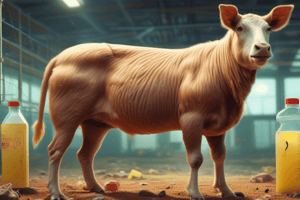Podcast
Questions and Answers
What is the purpose of Base Metabolic Rate (BMR) in an animal?
What is the purpose of Base Metabolic Rate (BMR) in an animal?
- To prevent the use of body tissue for energy (correct)
- To enhance heat increment of feeding
- To support growth and development
- To promote voluntary muscle activity
When is the Base Metabolic Rate (BMR) of an animal typically measured?
When is the Base Metabolic Rate (BMR) of an animal typically measured?
- When the animal is eating a balanced diet
- When the animal is not eating or doing any activity (correct)
- When the animal is actively foraging for food
- When the animal is engaging in high-intensity exercise
What is the Maintenance Energy Requirement (MER) of an animal?
What is the Maintenance Energy Requirement (MER) of an animal?
- BMR - heat increment of feeding
- BMR + heat increment of feeding + voluntary muscle activity (correct)
- BMR / heat increment of feeding
- BMR - voluntary muscle activity
What is the heat increment of feeding?
What is the heat increment of feeding?
Why is voluntary muscle activity included in the Maintenance Energy Requirement (MER) of an animal?
Why is voluntary muscle activity included in the Maintenance Energy Requirement (MER) of an animal?
What is the primary reason for measuring an animal's Base Metabolic Rate (BMR)?
What is the primary reason for measuring an animal's Base Metabolic Rate (BMR)?
What is the difference between Base Metabolic Rate (BMR) and Maintenance Energy Requirement (MER)?
What is the difference between Base Metabolic Rate (BMR) and Maintenance Energy Requirement (MER)?
Which of the following is NOT a component of an animal's Maintenance Energy Requirement (MER)?
Which of the following is NOT a component of an animal's Maintenance Energy Requirement (MER)?
What is the purpose of including heat increment of feeding in an animal's Maintenance Energy Requirement (MER)?
What is the purpose of including heat increment of feeding in an animal's Maintenance Energy Requirement (MER)?
What would happen to an animal if it did not meet its Maintenance Energy Requirement (MER)?
What would happen to an animal if it did not meet its Maintenance Energy Requirement (MER)?
Base Metabolic Rate (BMR) is measured when the animal is actively foraging
Base Metabolic Rate (BMR) is measured when the animal is actively foraging
The Maintenance Energy Requirement (MER) is equal to the Base Metabolic Rate (BMR) only
The Maintenance Energy Requirement (MER) is equal to the Base Metabolic Rate (BMR) only
The heat increment of feeding is a measure of the energy required for animal movement
The heat increment of feeding is a measure of the energy required for animal movement
Voluntary muscle activity is not included in the calculation of an animal's Maintenance Energy Requirement (MER)
Voluntary muscle activity is not included in the calculation of an animal's Maintenance Energy Requirement (MER)
Base Metabolic Rate (BMR) is the same as an animal's energy requirement for maintenance
Base Metabolic Rate (BMR) is the same as an animal's energy requirement for maintenance
What is one of the main purposes of energy in animals?
What is one of the main purposes of energy in animals?
Which of the following is NOT related to energy production in animals?
Which of the following is NOT related to energy production in animals?
What is the purpose of energy for reproduction in animals?
What is the purpose of energy for reproduction in animals?
Which of the following is a reason why energy is required in animals?
Which of the following is a reason why energy is required in animals?
What is the purpose of energy for growth in animals?
What is the purpose of energy for growth in animals?
What is the primary purpose of energy for maintenance in animals?
What is the primary purpose of energy for maintenance in animals?
Which of the following is a function of energy in animals?
Which of the following is a function of energy in animals?
What is one of the ways energy is utilized in animals?
What is one of the ways energy is utilized in animals?
Which of the following is not a category of energy utilization in animals?
Which of the following is not a category of energy utilization in animals?
What is the role of energy in reproduction in animals?
What is the role of energy in reproduction in animals?
What is one of the primary functions of energy in animals?
What is one of the primary functions of energy in animals?
In which category of energy utilization does the production of eggs fall under?
In which category of energy utilization does the production of eggs fall under?
What is the primary role of energy in reproduction in animals?
What is the primary role of energy in reproduction in animals?
What is the primary function of energy in growth in animals?
What is the primary function of energy in growth in animals?
Which of the following categories of energy utilization involves the use of energy for muscle movement?
Which of the following categories of energy utilization involves the use of energy for muscle movement?
What is the relationship between a female's nutrition and fertility?
What is the relationship between a female's nutrition and fertility?
What happens when a female is on a sub-maintenance diet?
What happens when a female is on a sub-maintenance diet?
When do nutrient requirements need to increase during pregnancy?
When do nutrient requirements need to increase during pregnancy?
What is the consequence of underfeeding a pregnant female?
What is the consequence of underfeeding a pregnant female?
Why should a female be fed smaller meals more frequently during the third trimester?
Why should a female be fed smaller meals more frequently during the third trimester?
What is the effect of a female's good nutrition and condition on her fertility?
What is the effect of a female's good nutrition and condition on her fertility?
What happens to a female's ovulation and a male's sperm production when they are on a sub-maintenance diet?
What happens to a female's ovulation and a male's sperm production when they are on a sub-maintenance diet?
Why should a female be fed smaller, more frequent meals during the third trimester of pregnancy?
Why should a female be fed smaller, more frequent meals during the third trimester of pregnancy?
What is the consequence of underfeeding a pregnant female on the fetus or offspring?
What is the consequence of underfeeding a pregnant female on the fetus or offspring?
What is the primary reason for feeding a female kitten food during the third trimester of pregnancy?
What is the primary reason for feeding a female kitten food during the third trimester of pregnancy?
What happens to a female's fertility when she has high levels of nutrition and is in good condition?
What happens to a female's fertility when she has high levels of nutrition and is in good condition?
What is the result of a sub-maintenance diet on a female's reproductive cycle?
What is the result of a sub-maintenance diet on a female's reproductive cycle?
When do a female's nutrient requirements need to increase during pregnancy?
When do a female's nutrient requirements need to increase during pregnancy?
What is the consequence of underfeeding a pregnant female on the fetus or offspring?
What is the consequence of underfeeding a pregnant female on the fetus or offspring?
Why is it recommended to feed a female kitten food during the third trimester of pregnancy?
Why is it recommended to feed a female kitten food during the third trimester of pregnancy?
What determines the amount of food required to satisfy an animal's needs?
What determines the amount of food required to satisfy an animal's needs?
What happens when feeding foods that contain high percentages of water?
What happens when feeding foods that contain high percentages of water?
What must the diet be a combination of?
What must the diet be a combination of?
Why is it necessary to consider energy content when formulating an animal's diet?
Why is it necessary to consider energy content when formulating an animal's diet?
What is the relationship between an animal's diet and its energy needs?
What is the relationship between an animal's diet and its energy needs?
Flashcards are hidden until you start studying
Study Notes
Base Metabolic Rate (BMR)
- Refers to the minimum energy required to prevent an animal from using its body tissue to keep itself alive
- Measured when the animal is in a state of starvation, i.e., not eating or engaging in any physical activity
Maintenance Energy Requirement (MER)
- Represents the total energy required for an animal to maintain itself
- Comprised of three components:
- Base Metabolic Rate (BMR)
- Heat increment of feeding (energy produced from food consumption, digestion, and metabolism)
- Voluntary muscle activity (energy expended for foraging and gaining food)
Base Metabolic Rate (BMR)
- Refers to the minimum energy required to prevent an animal from using its body tissue to keep itself alive
- Measured when the animal is in a state of starvation, i.e., not eating or engaging in any physical activity
Maintenance Energy Requirement (MER)
- Represents the total energy required for an animal to maintain itself
- Comprised of three components:
- Base Metabolic Rate (BMR)
- Heat increment of feeding (energy produced from food consumption, digestion, and metabolism)
- Voluntary muscle activity (energy expended for foraging and gaining food)
Base Metabolic Rate (BMR)
- Refers to the minimum energy required to prevent an animal from using its body tissue to keep itself alive
- Measured when the animal is in a state of starvation, i.e., not eating or engaging in any physical activity
Maintenance Energy Requirement (MER)
- Represents the total energy required for an animal to maintain itself
- Comprised of three components:
- Base Metabolic Rate (BMR)
- Heat increment of feeding (energy produced from food consumption, digestion, and metabolism)
- Voluntary muscle activity (energy expended for foraging and gaining food)
Energy Utilization in Livestock
- Energy is utilized for maintenance purposes, such as digestion and blood circulation, to support basic body functions.
- Energy is used for production, enabling the production of meat, milk, eggs, and other livestock products.
- Energy is essential for growth, providing the necessary energy for bone and muscle growth.
- Energy is utilized for reproductive purposes, supporting the growth of a calf, lamb, or the production of eggs.
- Energy is necessary for activity, facilitating muscle movement and enabling the animal to walk and move.
Energy Utilization in Livestock
- Energy is utilized for maintenance purposes, such as digestion and blood circulation, to support basic body functions.
- Energy is used for production, enabling the production of meat, milk, eggs, and other livestock products.
- Energy is essential for growth, providing the necessary energy for bone and muscle growth.
- Energy is utilized for reproductive purposes, supporting the growth of a calf, lamb, or the production of eggs.
- Energy is necessary for activity, facilitating muscle movement and enabling the animal to walk and move.
Energy Utilization in Livestock
- Energy is utilized for maintenance purposes, such as digestion and blood circulation, to support basic body functions.
- Energy is used for production, enabling the production of meat, milk, eggs, and other livestock products.
- Energy is essential for growth, providing the necessary energy for bone and muscle growth.
- Energy is utilized for reproductive purposes, supporting the growth of a calf, lamb, or the production of eggs.
- Energy is necessary for activity, facilitating muscle movement and enabling the animal to walk and move.
Nutrition and Reproduction
- Females in good condition and with higher nutrition levels have increased fertility and larger litters
- Sub-maintenance diet is associated with low fertility, cessation of ovulation, and reduced sperm production in males
Pregnancy and Nutrition
- Nutrient requirements increase during the last trimester of pregnancy due to rapid foetal growth
- Underfeeding can lead to reduced performance of the mother, weaker foetus/offspring, and lower survival rates
- Mothers will allocate nutrients to the foetus at the expense of their own health
Feeding Strategies
- Feeding smaller meals more frequently, or providing high-quality food, can help meet increased nutrient demands
- In the third trimester, feeding kitten food can provide necessary nutrients for foetal growth and development
Nutrition and Reproduction
- Females in good condition and with higher nutrition levels have increased fertility and larger litters
- Sub-maintenance diet is associated with low fertility, cessation of ovulation, and reduced sperm production in males
Pregnancy and Nutrition
- Nutrient requirements increase during the last trimester of pregnancy due to rapid foetal growth
- Underfeeding can lead to reduced performance of the mother, weaker foetus/offspring, and lower survival rates
- Mothers will allocate nutrients to the foetus at the expense of their own health
Feeding Strategies
- Feeding smaller meals more frequently, or providing high-quality food, can help meet increased nutrient demands
- In the third trimester, feeding kitten food can provide necessary nutrients for foetal growth and development
Nutrition and Reproduction
- Females in good condition and with higher nutrition levels have increased fertility and larger litters
- Sub-maintenance diet is associated with low fertility, cessation of ovulation, and reduced sperm production in males
Pregnancy and Nutrition
- Nutrient requirements increase during the last trimester of pregnancy due to rapid foetal growth
- Underfeeding can lead to reduced performance of the mother, weaker foetus/offspring, and lower survival rates
- Mothers will allocate nutrients to the foetus at the expense of their own health
Feeding Strategies
- Feeding smaller meals more frequently, or providing high-quality food, can help meet increased nutrient demands
- In the third trimester, feeding kitten food can provide necessary nutrients for foetal growth and development
Energy Content of Food
- Energy content of food is the principal factor determining the amount of food required to satisfy an animal's needs
- Fat, carbohydrates, and protein are energy-producing nutrients in food
- Foods with high water percentages are less calorie-dense, requiring greater amounts to be fed to provide the required energy
Importance of Balanced Diet
- A diet must be a combination of minimum requirements for various nutrients, including:
- Energy
- Protein
- Fat
- Carbohydrates
- Vitamins
- Minerals
Studying That Suits You
Use AI to generate personalized quizzes and flashcards to suit your learning preferences.




